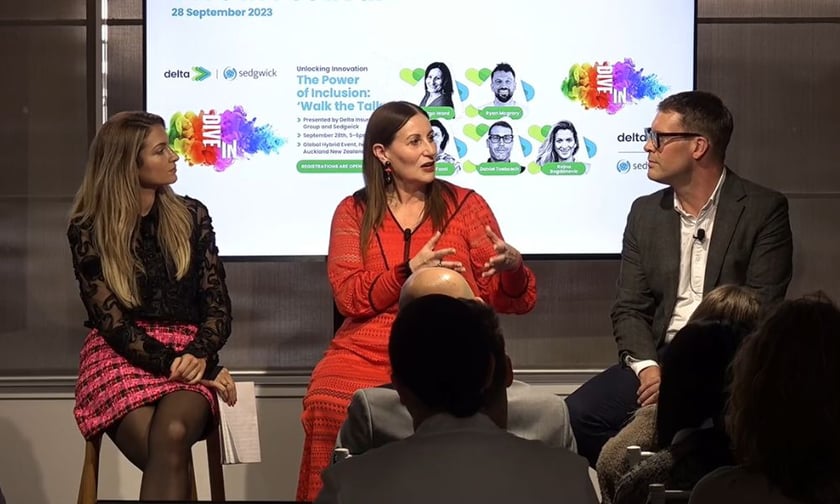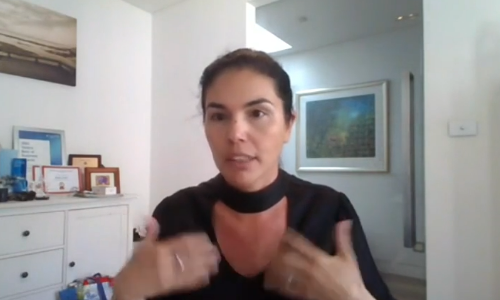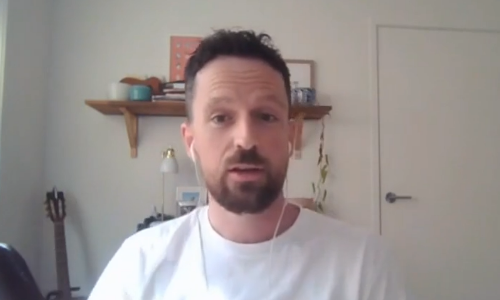

Exsona founder Ryan McGrory (pictured below, bottom) says his ‘bullsh*t detectors’ go off when he hears companies say they already have an inclusive culture, given that there are those who just talk the talk but aren’t walking the walk when it comes to diversity, equity, and inclusion (DE&I).
Speaking as a remote panellist during the ‘Walk the Talk’ Dive In event that was hosted by Delta Insurance and Sedgwick in Auckland, the employee experience enthusiast said: “We’re talking about creating an inclusive culture, so a place people feel that they belong, a culture that values diverse perspectives, and a culture that drives innovation.
“Funnily enough, 90% of businesses say that they have this already. You look at their website and you look at their comms, and my bullshit detectors go off a little bit when I hear or see it. McKinsey in 2022 found that only 36% of employees actually believe that organisations are doing an excellent job when it comes to fostering an inclusive culture.
“I’ve worked with organisations who talk the talk, say the right thing, but maybe lean a little too heavily on optics and not reality. I’ve also worked with organisations who literally walk the walk, who are really world-class in this area – they are a rarer breed, but they also reap the rarer benefits.”
Moderated by Delta casualty and financial lines underwriter Daniel Toebosch (pictured above, right), the panel discussion also featured The Rehabilitation Specialists managing director Fiona Fonti (pictured immediately below), KidsXpress chief executive and Chubb Insurance Australia board member Margo Ward (pictured above, centre), and First Response Health managing director Rajna Bogdanovic (pictured above, left).
Fonti, an occupational therapist who has lived with profound deafness and has an invisible acquired neurological disability, said companies should avoid turning diversity and inclusion into a tick box exercise and must instead be open to, say, adding people with lived experience to their rosters.
“Having lived experience in the team can actually give them perspective to approach and solve a problem, and that could lead to development of new products, services, processes, or even new businesses,” said Fonti, who joined the discussion from Australia. “So, maybe considering the employment of individuals with lived experience of health issues, mental health challenges, or disability could enhance the customer experience.
“The people interacting with the customers will be more easily able to build rapport and better direct clients to support that might be useful for them in the community. So, I really encourage organisations to broaden their recruitment network and be open to employing people maybe transitioning back to work or inviting those with disabilities or a medical condition to apply for a role. You might then develop new ways of working based on an individual’s lived experience that might help your business in ways that you don’t expect.”

For Ward, it’s all about – from the word “humankind” – being human and kind to the very best of our ability. For the charity founder, to be human to somebody, with their difference and whatever they bring, is to be present.
She told attendees of the event: “I run an organisation that supports children impacted by adversity and trauma, so children under 12, their families, their communities that have been affected by abuse, neglect, domestic violence, etc. They are a group that you need to be incredibly present to and be able to be incredibly supportive to, and they need to be included in society.
“When you look at trauma and its impact, the reality is we’re all impacted by trauma and adversity at some point in our lives and our career. When my career took me into the insurance industry, I started to ask the question around vicarious trauma.
“The industry, as a whole, is dealing with trauma every single day. You are hearing people’s stories; you are holding safe or creating a safe space and security for people in their most vulnerable time. So, ask questions around, ‘What are we doing for our people that we’re supporting them when they’re hearing trauma after trauma after trauma story?’”
Ward noted that one of the things that she’s seen beautifully done is businesses holding vicarious trauma training for their staff.
“Then they are supported themselves, they are safe themselves, and they’re able to really meet their community, their customers, their clients where they’re at,” she said. “Being human and kind is about meeting people where they’re at. And we in this industry, if we don’t understand what the impact of trauma is for our children, their families, their clients, each other, then we are missing a major opportunity to be human and kind.”
Bogdanovic, who is a clinical psychologist, shared that among the actions that firms can also take is supporting cross-functional teams to work together while ensuring that psychological safety exists.
She said: “What I see really successful organisations (that do DE&I really well) doing is they take seemingly unrelated teams – seemingly teams that may not work together or don’t work together usually or may not traditionally work together or shouldn’t work together – putting them together and supporting them to work together. We know that having cross-functional teams, and having teams engaged with each other, works really well. It supports innovation; it helps people to get to know each other better – an array of things. That’s the first point.
“The second thing that I want to mention is diversity, equity, and inclusion can be catalysed by one thing, and that is psychological safety. What it means is that you have this view or perception that you can be and act and say and speak authentically as you without fear of reprimand, without fear of embarrassment, without fear that you will be ostracised by the group or by your cohort, by your team, by your workplace. If you think about it, if we don’t have psych safety, DE&I initiatives either will not work or won’t work as well.
“From a very basic perspective, we’re talking here about leading authentically and asking the right questions. For example, not asking ‘How are you?’ I wish we could just take that out of our vocabularies. It is a very closed question. And what do we often say? ‘Good’, ‘busy’, some version of that. So, asking open-ended questions, leading authentically, leaving your ego at the door, and viewing humans as humans and not just resources. I would really encourage all of you to think about psychological safety as the floor of the house of diversity, equity, and inclusion.”
Bogdanovic believes that diversity of thought is everything as, in her view, it is what will take an organisation forward.

Meanwhile McGrory cited three things that he thinks are needed to achieve a successful culture in the workplace.
“One, give your people a voice and listen well,” McGrory said. “It can help to have an actual listening strategy, so a conscious and an ongoing effort to gain perspectives, feedback, and ideas from your people, and then take action by removing barriers by enabling improvements.
“The second is being intentional about diversity, equity, and inclusion, so have an actual strategy for DE&I. And I’m not talking about a calendar full of dress-up days and morning teas; I’m talking about an actual strategy – one with objectives, with targets, with actions, with solid communication, a plan, and a roadmap to help guide everything.
“The third thing is linking your DE&I strategy to your business strategy – what the business’s vision is, what the objectives are, what it’s trying to achieve – and then using that to inform and influence the creation of a DE&I strategy. Because I think when it’s used in this way, what you end up with is a strategy that actually supports the success of the business strategy and all stakeholders and not something that’s separate or is easily siloed.”
When a company’s listening strategy, DE&I strategy, and business strategy are all “singing in unison,” they help create a culture that listens well, takes action, collaborates, effectively shares ideas, drives innovation, and improves the lives of the people and the business, according to McGrory.
“I’ve seen this happen before and it is a beautiful thing,” he said. “The best practice strategy is one that’s integrated into all aspects of the organisation. At its core, it’s not only about ticking boxes or meeting regulatory requirements; it’s about creating a workplace where everyone feels that they can belong, can thrive, and can contribute to the success of the organisation.
“There are a number of things that directly impact how people experience this in organisations, and mostly it has to do with their experience with leadership, recruitment and hiring, training and development, policies and procedures, the culture that they’re in, and also how feedback and communication is done.
“The organisations who really stand out have two very important characteristics: one, they give a sh*t; two, they take action. If an organisation genuinely cares about something and they focus on taking action, sh*t gets done.”
What do you think about this story? Share your thoughts in the comments below.
